Regional election in Carinthia, 5 March 2023
Karin Liebhart
Senior lecturer (Privatdozent) in political science at the University of ViennaIssue
Issue #4Auteurs
Karin Liebhart
Issue 4, January 2024
Elections in Europe: 2023
Background and context
With 563,176 inhabitants (2021 microcensus), the southernmost federal state of Carinthia is one of Austria’s the less populous states, with fewer people living only in Salzburg, which is close behind, and in the small states of Vorarlberg and Burgenland (Statistik Austria, 2023). In 2022, Carinthia had the second-highest unemployment rate after the federal capital of Vienna, at 4.5%. With a disposable income of private households per capita of €24,000 in 2021, it was in joint second-last place with Tyrol and ahead of Vienna (Statistik Austria, 2023b). The tourism sector plays an important role in the state’s economy, accounting for 15% of GDP and an annual gross added value of €2.4 billion (Office of the Carinthian Regional Government, 2023).
Elections to the Carinthian provincial parliament, the 36-seat unicameral regional legislature (the number of seats in which has remained unchanged since 1945), take place every five years. The minimal voting age is 16, like the general voting age in Austria. Voting takes place in four constituencies, with voters awarding preferential votes to a maximum of three candidates from the chosen party (Federal legal information system RIB, 2023).
The Social Democratic Party (SPÖ) has a long tradition of electoral success in Carinthia. In most provincial elections since 1945, the SPÖ has received the highest number of votes and subsequently also provided the provincial governor (Landeshauptmann). Exceptions are the years 1989 to 1991 and 1999 to 2008, when the controversial right-wing populist Jörg Haider, who is known beyond Austria’s borders, was Carinthia’s governor. Between 1991 and 1999, the Austrian People’s Party (ÖVP) provided the Carinthian governor with the help of the SPÖ. The FPÖ emerged as the party with the most votes for the first time in the 1999 provincial elections. Jörg Haider first stood as a candidate for the Freedom Party of Austria (FPÖ), of which he was chairman until 2000, and then for his own party, the Alliance for the Future of Austria (BZÖ), following the split he instigated in 2005 after internal party disputes (Schubert & Klein, 2021). In the regional elections held shortly after Haider’s fatal accident with his official car in 2008, the BZÖ was once again able to win enough votes to fill the office of provincial governor.
With the 2013 election, the balance of power in the Carinthian state parliament changed significantly and Carinthia became the third Social Democratic bastion in Austria under new governor Peter Kaiser, alongside the federal capital Vienna and Burgenland. Kaiser held the office of deputy governor from 2010 to 2013 and has been party chairman of the SPÖ Carinthia since 2010. In the 2018 regional elections, the SPÖ achieved 47.9% of the vote, an increase of more than ten percentage points compared to 2013. The FPÖ also made significant gains and achieved 23% (more than six percentage points above the 2013 result). The ÖVP gained around one percentage point with 15.5%. Although Team Kärnten lost five and a half percentage points compared to 2013, it was the fourth party to enter parliament with 5.7%.
The national significance of the 2023 regional election
The Carinthian regional election in 2023 was seen both as a chance and a potential nail-biter by the federal Social Democratic Party and its then chairwoman Pamela Rendi-Wagner (Müller 2023). From the Social Democrats’ perspective, a good election result in Carinthia could have provided positive momentum to the party as a whole and, particularly, its party leader. This would have been urgently needed after the SPÖ’s very disappointing result in the Lower Austrian state parliament elections in January 2023. In the regional elections in Lower Austria, which were dominated by federal policy issues such as asylum, migration and inflation, the SPÖ came in third for the first time with 20.7% (2018: 23.9%) behind the FPÖ with 24.2% (2018: 14.8%) (Neuhold, 2023). In contrast to the SPÖ, the Freedom Party not only benefited from the programmatic focuses of the Lower Austrian election campaign, but ultimately even became part of the governing coalition with the ÖVP as a junior partner. The ÖVP lost around ten percentage points, standing at 39.9% (2018: 49.6%), while still remaining the largest party in the region. Falling approval ratings for the federal SPÖ and its leader made the Carinthian state election appear as a kind of “life insurance” for the SPÖ and Pamela Rendi-Wagner. Accordingly, during visits to Carinthia in the run-up to the election, the party leader referred to Carinthia as a model region that had achieved a “comeback” after ten years of successful social democratic leadership. During the election campaign, Peter Kaiser himself spoke of the “shambles” he had taken over in 2013 and cleared away in the first legislative term, before Carinthia was stabilised again in the second legislative period under an SPÖ-ÖVP coalition and the state’s reputation improved (Müller, 2023). The Carinthian SPÖ campaigned on the issues of inflation, environment, climate, economy, education, housing and health.
A favourable outcome for the SPÖ also seemed realistic in the run-up to the election, as Peter Kaiser, who has now been governor of the province for ten years, had almost achieved an absolute majority of votes in 2018 and performed relatively well in the polls before the 2023 election. Only slight losses were therefore expected. According to the platform Statista, surveys conducted by various institutes in February 2023 placed the SPÖ in a range between 42% and 46% of the vote (Mohr, 2023). The Social Democrats seemed to have a good chance of success after a long dry spell (ORF, 2023).
However, things turned out differently than expected.
A surprising election result
A total of ten entities that had submitted proposals for electoral lists by the deadline stood in the 2023 state parliamentary elections.
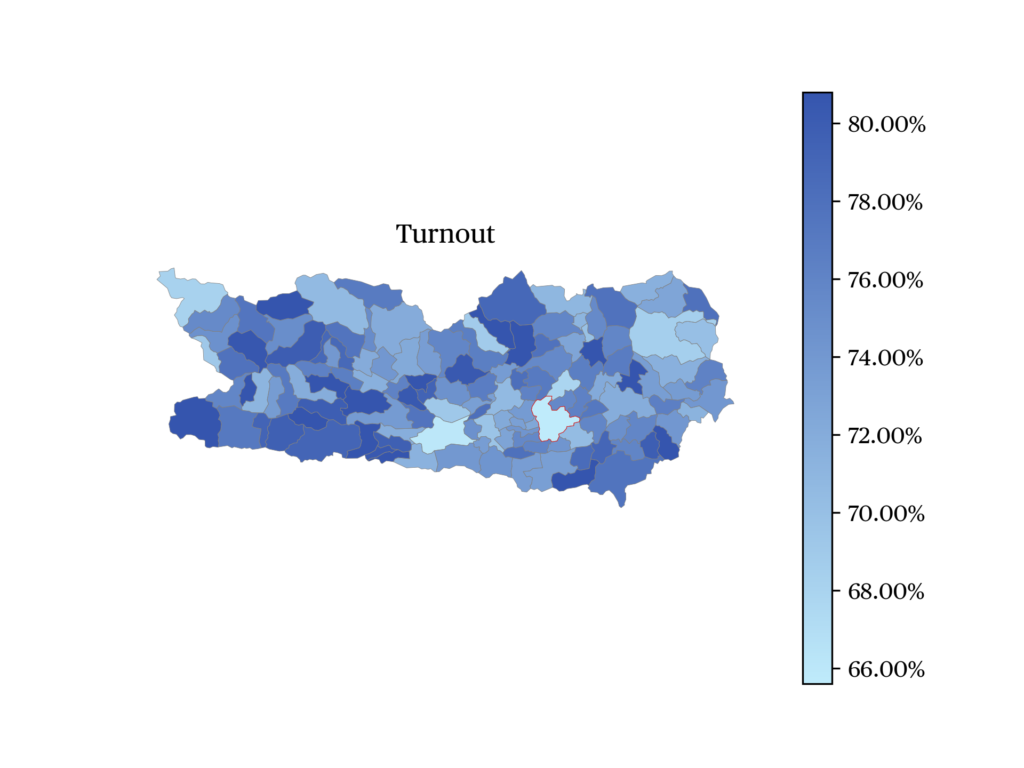
Five years after a historical low of 68.6% in 2018, voter turnout was this time around three percentage points higher, reaching 71.7%. However, turnout was distributed quite unevenly across the individual districts and regions of Carinthia and fluctuated between less than 66% and more than 80%.
The charts in “the data” provide an overview of the election results.
As expected, the incumbent Social Democratic governor Peter Kaiser emerged victorious from the regional elections on 5 March 2023 with 38.9% of the vote, albeit with a significant loss of nine percentage points compared to the 2018 election. The result fell short of expectations, although the SPÖ emerged from the elections as by far the strongest party despite considerable losses (Kleine Zeitung, 2023). The two charts below show the losses of the SPÖ and the gains of the FPÖ and ÖVP since 2018. With a few exceptions, both parties were able to attract new voters primarily in the north-western and northern regions of Carinthia and in central Carinthia.
The ÖVP, for which Carinthia is traditionally a “difficult terrain” (ORF, 2023), surprisingly managed to gain votes and clearly defend its third place from the 2018 election. Pre-electoral polls had predicted that the party would slump (Kleine Zeitung, 2023). The FPÖ, whose youth organisation had warned of a “Slovenianisation” of Carinthia during the election campaign, causing a diplomatic scandal with Slovenia, and Team Kärnten (which is part of the same political spectrum and appeals to similar groups of voters as the FPÖ) were also among the winners of the election (Die Presse, 2023). With 24.5% (and an increase of 1.6%), the FPÖ came in second. With 32% of the vote, the FPÖ was particularly successful among voters under 30, while the ÖVP was particularly successful among voters over 60 with 25%.
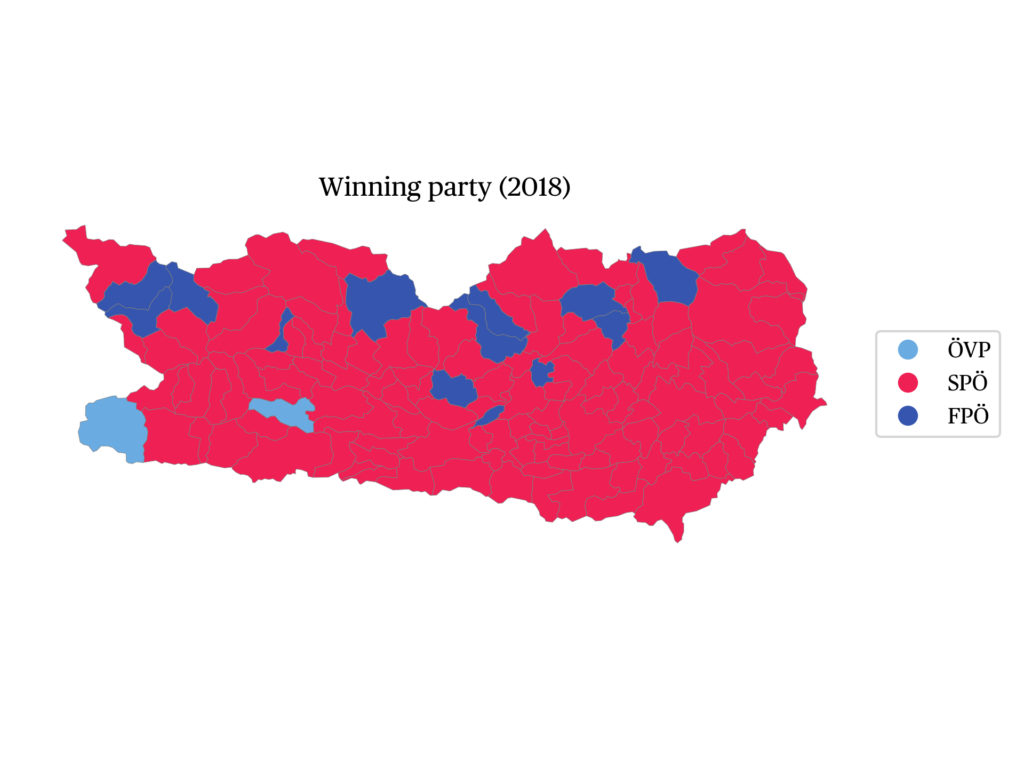
Team Kärnten received 10.1% (an increase of 4.4% compared to 2018) and came fourth. This party had already performed remarkably well in the 2021 local elections and celebrated successes in mayoral elections in some Carinthian municipalities, including the provincial capital of Klagenfurt.
Neither the Greens, who left the Carinthian state parliament in 2018, nor the NEOS, who have never been represented in the Carinthian state parliament before, nor any of the other parties that contested the state parliament elections were able to pass the 5% threshold to enter the state parliament. This applies to the Vision Kärnten party, which emerged from the anti-vaccination party Menschen-Freiheit-Grundrechte (MFG) founded during the Covid-19 pandemic, as well as the BZÖ, which formed an “Alliance for Carinthia” together with other lists with the aim of continuing Jörg Haider’s legacy. Despite minimal gains, both the Greens (3.9%) and the NEOS (2.6%) failed to reach the 5% threshold.
Consequences of the election
The election result is reflected in the distribution of seats in the state parliament: the SPÖ now has 15 MPs (-3), the FPÖ 9, the ÖVP 7 (+1) and Team Kärnten 5 (+2).
Exactly one month after the election, the new Carinthian state government was formed on 5 April 2023 following successful coalition negotiations between the SPÖ and ÖVP, and a coalition agreement was signed Mathematically, the SPÖ could have formed a coalition with any of the other three parties and an FPÖ-ÖVP-Team Carinthia coalition without the participation of the SPÖ would also have been possible. However, the decision was made to continue the cooperation between the Social Democratic Party and the People’s Party in the Kaiser III cabinet 1 . The ÖVP’s top candidate Martin Gruber became Second Deputy Governor, while the rest of the government team of the new Carinthian red-black coalition remained the same as before the election. Three of the seven state councillors are women and four are men. The SPÖ has five members of the provincial government (including the governor) and the ÖVP has two. The coalition agreement defines sustainability and the energy transition as the focal points of the government’s work, with a focus on the United Nations’ 17 Sustainable Development Goals (Gress, 2023).
The Carinthian election result also had an impact on the Second Chamber of the Austrian Parliament, whose composition crucially depends on the balance of power in the nine provincial parliaments. One seat in the Federal Council went from the SPÖ to the ÖVP, leading to the federal government of the ÖVP and Greens regaining its majority in the Second Chamber after a temporary loss following the state parliamentary elections in Lower Austria on 31 January 2023 (Parlement Österreich, 2023).
The data
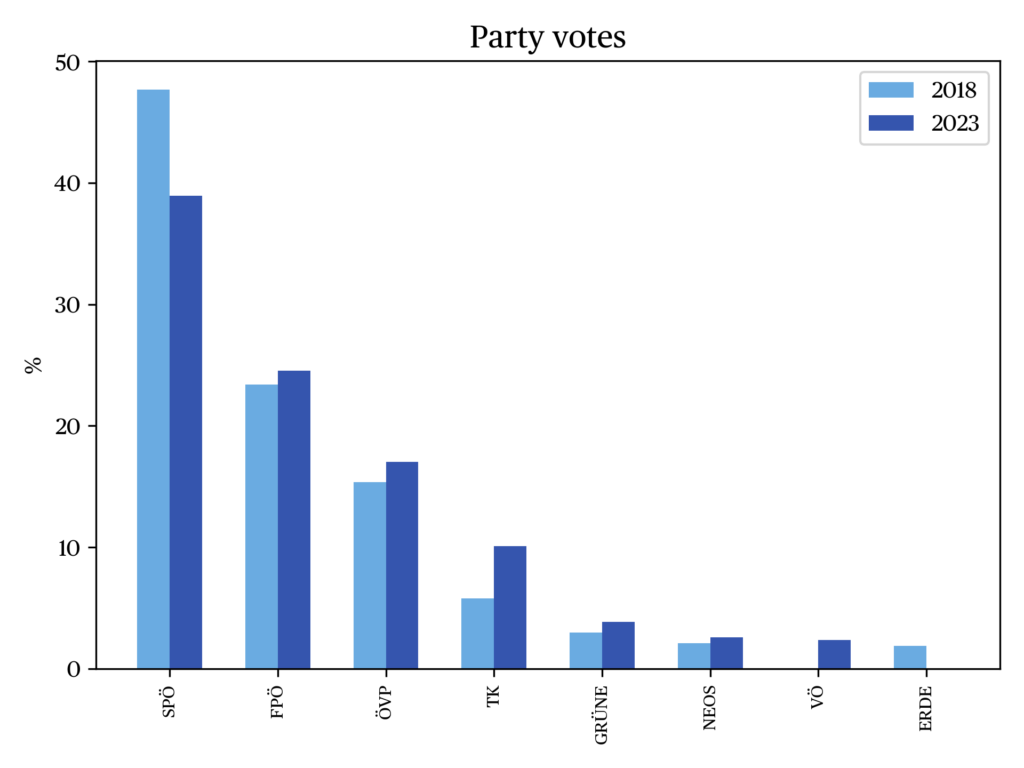

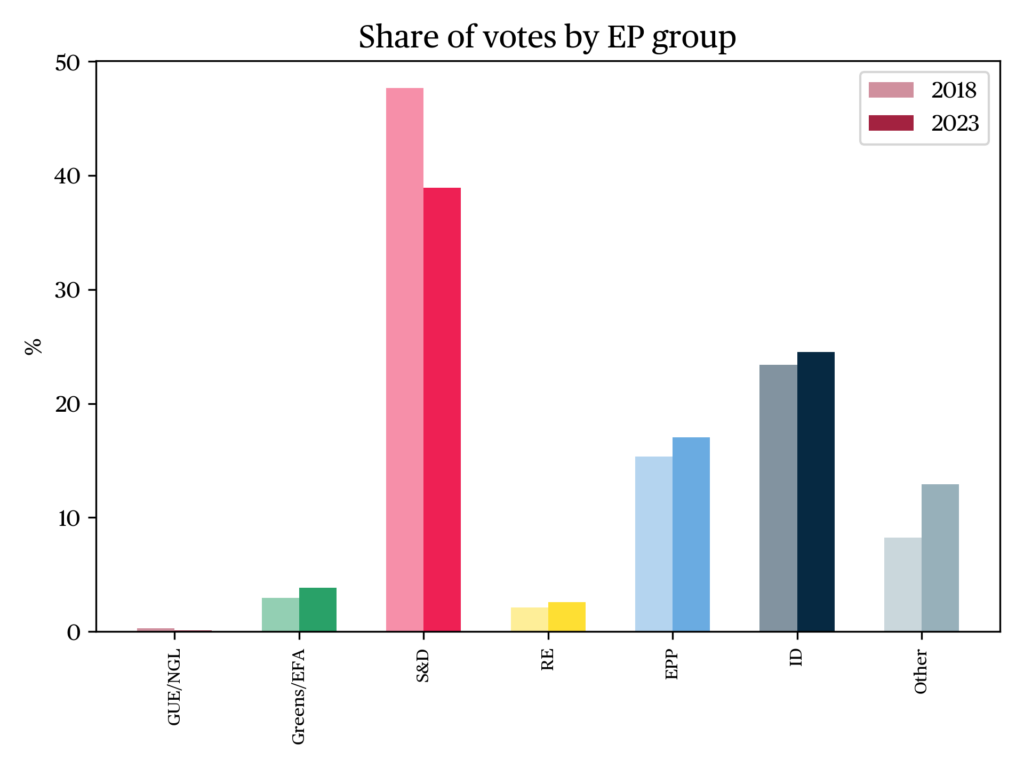
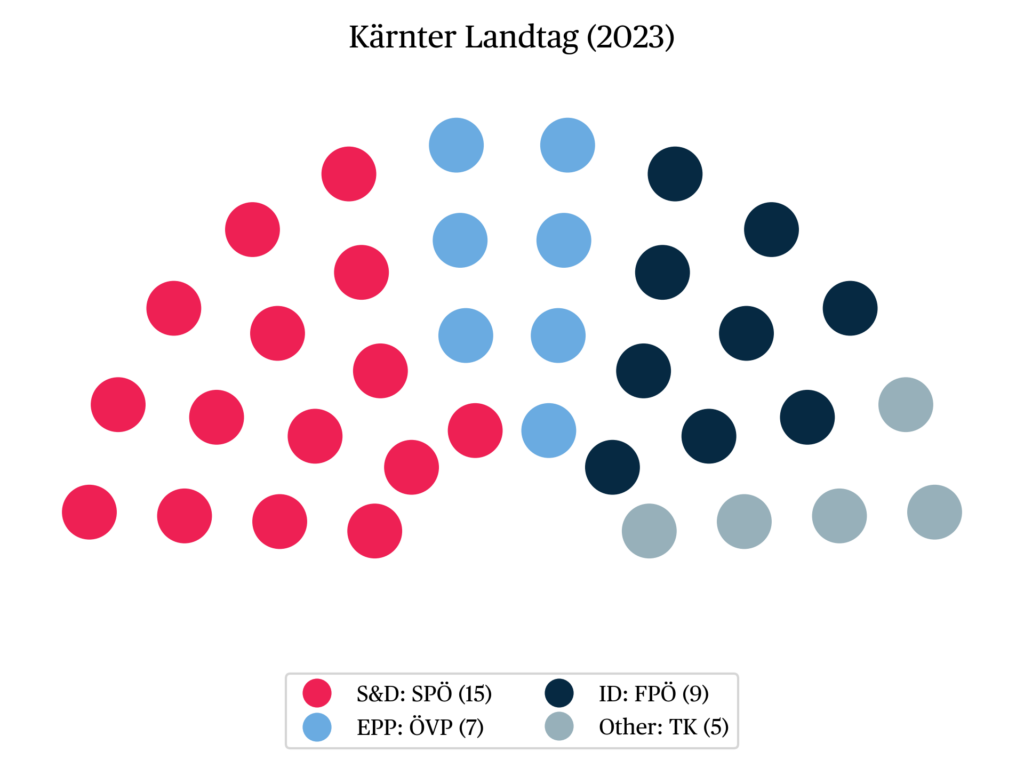
References
Die Presse (2023, 20 February). Kärntner haben eine “populistische Alternative” zur FPÖ. Die Presse.
Gress, J. (2023, 13 April). Nach Landtagswahl 2023 in Kärnten: SPÖ-ÖVP-Koalition besiegelt. News.
Federal legal information system RIB (2023). Landesrecht konsolidiert Kärnten: Gesamte Rechtsvorschrift für Kärntner Landtagswahlordnung – K-LTWO. Online.
Kleine Zeitung (2023, 5 March). Endergebnis sorgt für Katerstimmung bei der SPÖ und großen Jubel bei der ÖVP. Kleine Zeitung.
Mohr, M. (2023). Welche Partei würden Sie wählen, wenn am nächsten Sonntag Landtagswahl in Kärnten wäre? Sonntagsfrage zur Landtagswahl in Kärnten nach Instituten Februar 2023. Statista.
Müller, W. (2023, 21 January). Wahlkampfauftakt in Kärnten: Das südliche Hoffnungsland der SPÖ. Der Standard.
Neuhold, C. (2023, 29 January). SPÖ: Jetzt kann nur noch Kaiser Rendi-Wagner retten. Profil.
Office of the Carinthian regional government (2023). Eine starke Säule der Wirtschaft, Der Kärntner Tourismus. Online.
ORF (2023, 3 March). KÄRNTEN-WAHL. Auch Wien blickt nach Klagenfurt. ORF.
Parlement Österreich (2023, 6 March). Parlamentskorrespondenz Nr. 241.
Schubert, K. & Klein, M. (2020). Freiheitliche Partei Österreichs (FPÖ)/Die Freiheitlichen. In kurz&knapp. Das Politiklexikon. Bundeszentrale für Politische Bildung.
Statistik Austria (2023). Mikrozensus, Regionale Gesamtrechnungen, F&E-Statistik. Online.
Statistik Austria (2023b). Fact Sheet Österreich und seine Bundesländer. Online.
Notes
citer l'article
Karin Liebhart, Regional election in Carinthia, 5 March 2023, Jun 2024,
à lire dans cette issue
voir toute la revue





